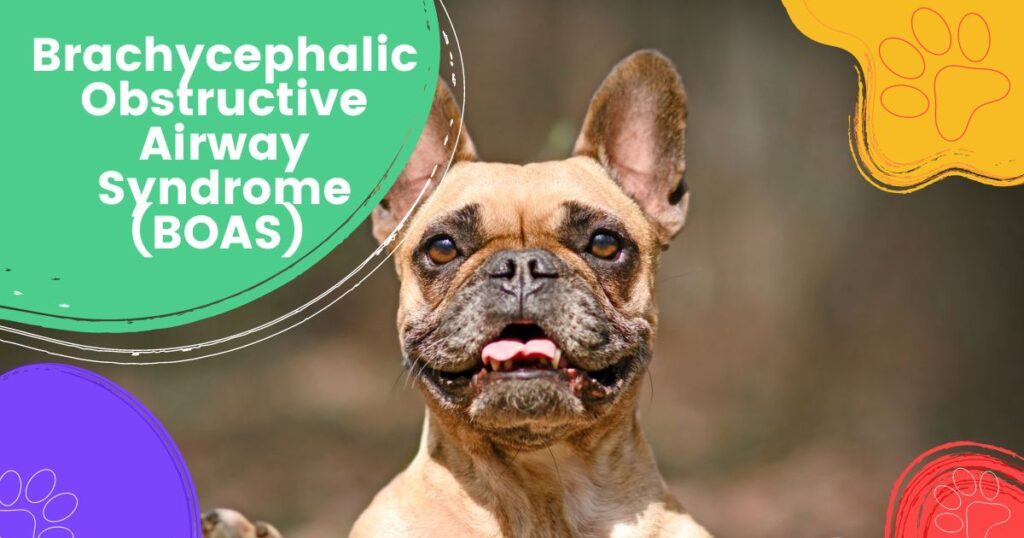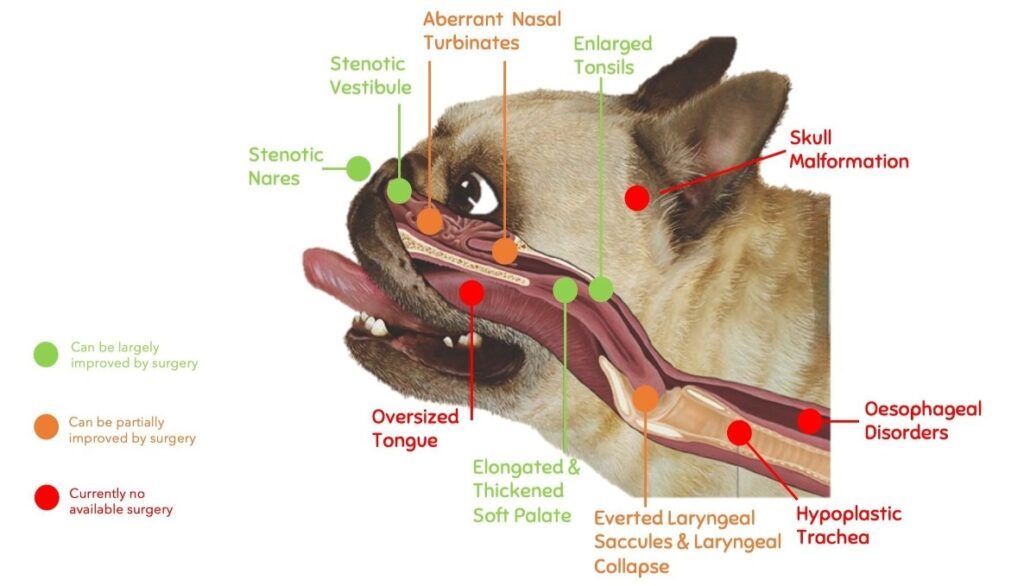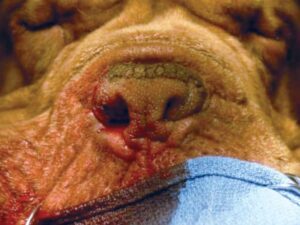Cosa significa brachicefalico?
Il termine brachicefalico deriva dal brachy greco che significa "corto" e cefalico che significa "testa", cioè gli animali brachicefalici sono quelli con teste corte.
Pertanto, i cani o i gatti brachicefalici hanno ossa del cranio che sono ridotte di lunghezza, dando al viso e al naso un aspetto spinto. A causa delle ossa più brevi del viso e del naso, l'anatomia e la relazione con le altre strutture dei tessuti molli vengono modificati; Alcuni di questi cambiamenti possono causare problemi fisici per l'animale interessato.

Che cos'è la sindrome delle vie aeree ostruttive brachicefaliche (BOAS)?
La sindrome delle vie aeree ostruttive brachicefaliche è il termine dato agli effetti che la testa abbreviata di questi animali ha sul passaggio dell'aria attraverso le vie aeree superiori. I segni possono variare in gravità da lieve russare o sbalordizioni a gravi problemi di respirazione.
Gli animali che soffrono di boa clinicamente significativi possono lottare per respirare durante l'esercizio e possono soffrire di collasso a causa della mancanza di aria. La dipendenza dai cani sul pantalone per raffreddarti rende anche animali che soffrono di boa molto suscettibili al surriscaldamento e allo sviluppo di difficoltà respiratorie potenzialmente molto gravi in condizioni calde.

Quali razze sono interessate?
Le razze brachicefaliche includono quelle razze di cane e gatto che hanno un aspetto ovvio, caratteristico corto o schiacciato. Qualsiasi razza di cane o gatto con una conformazione della testa brachicefalica può essere influenzata, ad esempio:
Cani:
Boston Terrier, pugile, boxer, Bull Mastiff, Bulldogs (francese e inglese), re Cavalier Charles Spaniel, Shar-Pei cinese, Dogue de Bordeaux, Lhassa Apso, Pechinese, Pug, Shih Tsu
Gatti:
Persiano, himalayan
Perché questi animali hanno problemi?
Ci sono quattro aree principali di preoccupazione per questi animali:
Mentre i cani sono comunemente presentati ai veterinari con problemi clinicamente significativi derivanti da boa, raramente i gatti vengono presentati per il trattamento. Questo può in parte essere un riflesso dello stile di vita più sedentario di alcuni gatti rispetto ai cani; La maggior parte dei gatti presentati richiede solo un trattamento per le narici ristrette (narici).
Le narici ristrette (narici) possono aumentare drasticamente la resistenza al flusso d'aria nel naso delle razze brachicefaliche. Questo, combinato con la tendenza ai supporti della cartilagine delle narici a crollare durante l'ispirazione, richiede uno sforzo molto più grande del normale da respirare.
Un palato morbido su sottobosco può ostruire parzialmente il flusso d'aria nella trachea (trachea) e causare anche flusso d'aria turbolento nell'area della laringe (casella vocale). Entrambi questi effetti aumentano ulteriormente lo sforzo richiesto affinché un animale colpito respiri e può causare una significativa infiammazione delle vie aeree superiori.
Sfortunatamente, lo sforzo extra richiesto per respirare (ispirazione) alla fine comporta problemi secondari, poiché le vie aeree non sono adattate per far fronte alla turbolenza e alle maggiori pressioni negative che si sviluppano.
Questi effetti secondari includono:
Come viene diagnosticata Boas?
Quando esegui un esame fisico, il veterinario di base valuterà l'anatomia del tuo cane o gatto (alcune teste sono più brevi di altre) e il comportamento del tuo animale domestico in determinate circostanze.
La maggior parte degli animali brachicefalici sperimenterà un grado di ostruzione delle vie aeree superiori, solitamente evidente come rumori sbuffi o russanti. La chiave è per te e il tuo chirurgo veterinario decidere tra te se il tuo animale sta vivendo un livello significativo di segni o mostra una conformazione anatomica che può predisponderlo ai problemi. La discussione coinvolgerà il modo in cui l'animale affronterà l'esercizio o le condizioni calde e anche qualsiasi probabile suscettibilità al deterioramento secondario all'interno delle vie aeree.
Sfortunatamente, solo le narici (narici) possono essere correttamente valutate senza il requisito per un anestetico generale. Inizialmente, pertanto, la diagnosi si basa sulla valutazione complessiva del chirurgo veterinario, ma richiederà ulteriori indagini per confermare la diagnosi.
Come fa il chirurgo veterinario indaga su Boas?
Potrebbero essere richiesti diversi test, a seconda dei risultati dell'esame fisico iniziale. Questi possono includere esami del sangue, valutazioni cardiache (cuore) e radiografie toraciche. Tuttavia, una valutazione completa delle vie aeree richiederà un anestetico.
L'anestesia generale nei cani brachicefalici può essere associata ad un aumento del rischio, in particolare durante le fasi di induzione e recupero.
Molti chirurghi veterinari delle cure primarie sceglierebbero di indirizzare questi casi a un chirurgo esperto per valutare le vie aeree in anestesia generale, con il vantaggio che il trattamento chirurgico può essere effettuato sotto lo stesso anestetico e quindi ridurre i rischi durante la fase di recupero.
Il chirurgo può utilizzare un endoscopio (piccola fotocamera) per esaminare l'esofago per segni di reflusso gastrico.
Quali opzioni di trattamento sono disponibili?
Nares stenotiche (narici ristrette)
La rimozione di una sezione della cartilagine della parte anteriore del naso o una sezione di pelle accanto al naso può migliorare il flusso d'aria attraverso le narici.

Un Dogue de Bordeaux a seguito di un intervento chirurgico da un lato per migliorare il flusso d'aria attraverso la narice
Palato morbido su sotto
La lunghezza in eccesso del palato molle può essere ridotta mediante un intervento chirurgico per ridurre l'interferenza con il flusso d'aria nella laringe (casella vocale).

Prima dell'intervento chirurgico per abbreviare il palato morbido

Dopo un intervento chirurgico per abbreviare il palato morbido
Collasso laringeo
Il collasso laringeo precoce può talvolta essere migliorato dalla rimozione di alcuni tessuti che rallenta il flusso d'aria. Il chirurgo valuterà la laringe (casella vocale) e deciderà se ulteriori interventi chirurgici in quest'area sono appropriati o probabilmente utili. A volte, potrebbe essere necessario eseguire questa procedura aggiuntiva in un secondo momento.
È improbabile che un collasso grave (grado 3) traggerà notevolmente una procedura minore e può richiedere una tracheostomia permanente (foro di respirazione nel collo) o a volte può essere temporaneamente migliorato con una procedura di tieback (vedere la scheda informativa di paralisi laringea).
Tonsille eventuali
Alcuni casi possono beneficiare della tonsillectomia (rimozione delle tonsille). La decisione se questo è appropriato è presa al momento della valutazione e della chirurgia.
Reflusso acido
Il trattamento per il reflusso gastrico di solito comporta farmaci regolari, piuttosto come si potrebbe prendere per il bruciore di stomaco.
Hiatal Hernia
In generale, la gestione conservativa è inizialmente impiegata in casi che soffrono di spostamento di una sezione dello stomaco nel torace, sebbene alcuni casi richiedano un trattamento chirurgico.
Gestione del peso
Lo stile di vita di molti di questi pazienti può predisponderli all'obesità. La perdita di peso può migliorare drasticamente il flusso d'aria attraverso la faringe e il collo e deve far parte del protocollo di trattamento nei pazienti in sovrappeso.
Qual è la prognosi (prospettiva) per il mio cane o gatto?
La maggior parte dei cani che soffrono di segni clinici di boa che ricevono un rapido trattamento adeguato può sperimentare un significativo miglioramento della tolleranza all'esercizio e della respirazione. Tuttavia, poiché il chirurgo non può mai creare vie aeree completamente normali per gli animali brachicefalici, rimangono suscettibili allo stress da calore e è improbabile che molti siano in grado di esercitare a un livello che ci si potrebbe aspettare dagli animali con normale conformazione della testa.
Si spera generalmente che un intervento chirurgico alle narici, al palato molle e alla laringe rallenterà la progressione del crollo laringeo (collasso della casella vocale) migliorando il flusso d'aria e riducendo le pressioni negative sviluppate durante la respirazione. La chirurgia precoce, effettuata prima che il collasso laringeo sia diventato grave, dovrebbe massimizzare il beneficio dalla chirurgia e ridurre al minimo i rischi di un significativo collasso laringeo più avanti nella vita.
Molti cani non sperimentano un ulteriore deterioramento significativo nella laringe durante la loro vita e quindi non richiedono mai ulteriori interventi chirurgici. Sfortunatamente, nonostante il trattamento, il collasso laringeo può raggiungere un livello critico in alcuni casi e può richiedere ulteriori interventi chirurgici ad un certo punto in futuro.
Nonostante le numerose precauzioni prese dai veterinari nella valutazione e nel trattamento di questi pazienti, il rischio di anestetico generale e chirurgia alle vie aeree non può mai essere eliminato. I chirurghi e gli anestesisti di North Downs Specialist Referral sono profondamente consapevoli delle esigenze speciali dei pazienti brachicefalici sottoposti a anestesia generale e chirurgia delle vie aeree.
La trachea ipoplastica (piccola trachea) non può essere trattata e questi cani sono spesso gravemente colpiti dalla compromissione del flusso d'aria associato a questa condizione.

| Biscotto | Durata | Descrizione |
|---|---|---|
| cookielawinfo-checkbox-analytics | 11 mesi | This cookie is set by GDPR Cookie Consent plugin. The cookie is used to store the user consent for the cookies in the category "Analytics". |
| cookielawinfo-checkbox-funzionale | 11 mesi | The cookie is set by GDPR cookie consent to record the user consent for the cookies in the category "Functional". |
| cookielawinfo-checkbox-necessario | 11 mesi | This cookie is set by GDPR Cookie Consent plugin. The cookies is used to store the user consent for the cookies in the category "Necessary". |
| cookielawinfo-checkbox-altri | 11 mesi | This cookie is set by GDPR Cookie Consent plugin. The cookie is used to store the user consent for the cookies in the category "Other. |
| cookielawinfo-checkbox-performance | 11 mesi | This cookie is set by GDPR Cookie Consent plugin. The cookie is used to store the user consent for the cookies in the category "Performance". |
| visti_cookie_policy | 11 mesi | Il cookie viene impostato dal plug-in GDPR Cookie Consent e viene utilizzato per memorizzare se l'utente ha acconsentito o meno all'uso dei cookie. Non memorizza alcun dato personale. |